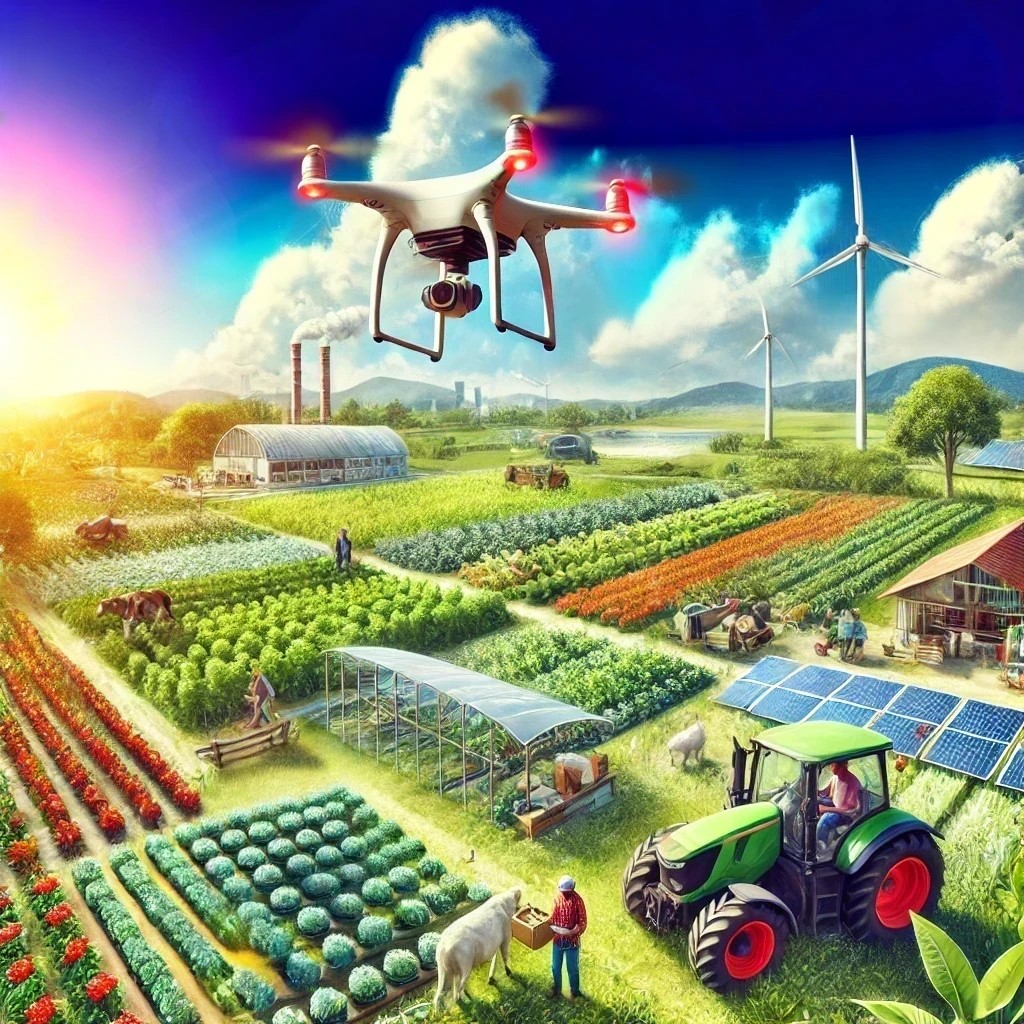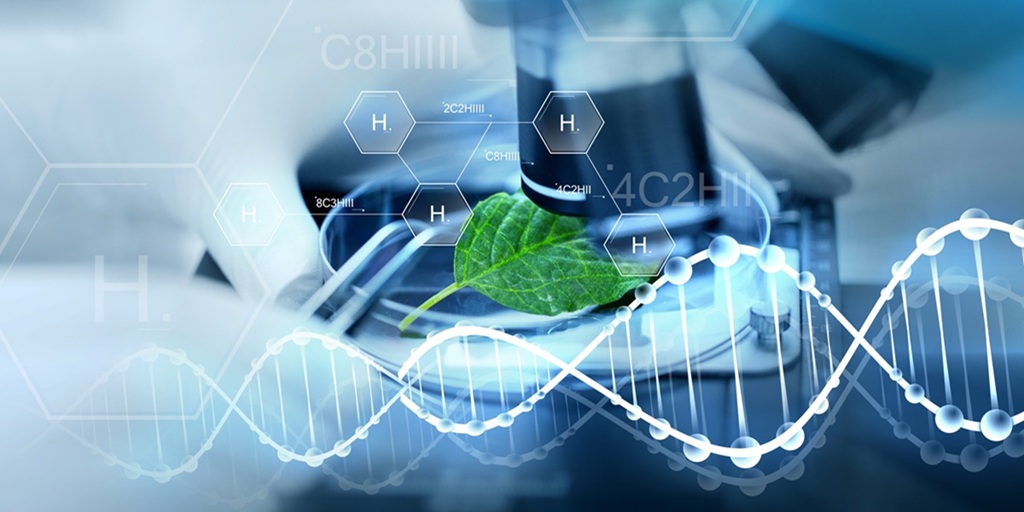
Economic Impact and Contributions
Agriculture is the world’s largest industry. It is a practice to cultivate natural resources to sustain life and provide economic gains. Agriculture includes cash crops such as rubber, oil palm, and cocoa, crops grown to raise livestock, aquaculture, and the use of raw materials for fossil fuel. The agriculture industry contributes 4.3% to the world’s GDP in 2021 and a quarter of the world’s labour force is in agriculture. The employment of more than one billion people generates 9.5 billion tonnes of primary crops that were used as food, feed or materials in products ranging from biofuels to cosmetics. In some least developing countries, agriculture can account for more than 25% of the nation’s GDP. In Malaysia, agriculture used to be the main contributor to our income and foreign exchange with 6.6% of the GDP in 2022. Malaysia’s global agricultural trade reached $61.3 billion in 2022 with exports of USD 37.4 billion and imports of USD 23.9 billion.
Although agriculture serves as the primary source of sustenance for humankind, it also has negative consequences. It is one of the greatest contributors to global warming, pollutes our waters significantly through the activities of farming, and accelerates the loss of biodiversity. The environmental challenges posed by the agriculture industry are alarming and will only become of more concern due to the growing need for food worldwide to accommodate the world population growth. In addition, the rise in global prosperity and the growing demand for meat, eggs, and dairy products are intensifying the pressure for increased production of corn, soybeans, and other crops to feed more cattle, pigs, and chickens. This cycle exacerbates the negative impacts of agriculture.
The Rising Demand for Food
The world’s population is steadily increasing, leading to greater demand for food and resources. Agriculture must adapt to meet this growing demand while also considering factors like urbanization and changing dietary preferences. The world’s population is expected to increase from the current 8 billion to 9.7 billion in 2050 and projected to reach 10.4 billion in 2100. The increment in the world population considers a few factors such as fertility rates, increasing longevity, and international migration. In 2022, Malaysia’s population is at an estimated 32.4 million people, and in 2040 the projected population is 41.5 million with an annual growth rate of 0.8%. This steady increase adds to the rapid population growth in Asia which is expected to rise to 5.3 billion in 2050. To feed the growing population, crop production must double, from one billion tonnes to two billion tonnes.

Figure 1: World population projection.
(Source: https://ourworldindata.org/region-population-2100)
The impact of acceleration in gaining high crop yield through agriculture could be seen in the water, energy, health, and biodiversity aspects. Agriculture serves the purpose of combatting hunger and malnutrition, in line with the UN Sustainable Development Goals (SDGs) namely SDG 2 (zero hunger), other SDGs are closely related such as SDG 6 (clean water and sanitation), 13 (climate action), 15 (life on land), 1 (no poverty), 12 (consumption), and 14 (life below water). Indeed, as one of the most water-intensive sectors, agricultural practices degrade water resources by inputting fertilizers and pesticides and have been shown to damage freshwater and coastal ecosystems. In addition, water irrigation, which is one of the means to supply water to crops could be threatened by increasing water scarcity and by diverting water from its natural resources, it affects the ecosystems that are dependent on these natural water bodies.
Agriculture, Climate Change and Health Impications
Shifts in climate patterns pose significant challenges to agriculture, including extreme weather events, unpredictable rainfall, and rising temperatures. Agriculture could have a potential role in climate change mitigation by reducing greenhouse gas emission. For example, improving the manure management of livestock to significantly reduce the source of methane and nitrous oxide emissions. Furthermore, the use of biomass as a renewable energy source for various energy services would be a more sustainable alternative to fossil fuels. The use of bioenergy for land rehabilitation such as planting bioenergy crops can improve soil fertility and structure by reducing erosion and water retention capacity. Farmers must adopt resilient and sustainable practices to mitigate the impact of climate change on crop yields and livestock.
In the health aspect, agriculture plays an important role in the lives of the poor where it serves as a source of livelihood and is also the main consumption expenditure. However, farming is a labour-intensive agriculture and since it is the main source of income for poor families, mothers are also normally involved in the work process. This contributes negatively to maternal health hence reducing the weight gain in their pregnancies. Pesticides could also have a negative impact on human health and the environment. By applying chemicals to maintain the quality of yield, workers are highly exposed to pesticides, and this can lead to acute and chronic health effects. Another impact on health and wellbeing is due to the emergence of highly contagious viral diseases of livestock. The risk of diseases such as avian influenza, swine influenza (H1N1) and foot-and-mouth disease is highly increased because of globalization and enhanced trade in livestock and their products. Insects, diseases, and weeds pose constant threats to agricultural productivity. Developing effective pest management strategies, promoting crop diversity, and investing in disease-resistant crop varieties are essential for safeguarding yields and a sustainable approach should be considered to lessen the health risk to humans, animals and the environment.
Policy and Institutional Reforms
Biodiversity and agriculture interactions are very important aspects that need to be considered. The dependence of farmers on landraces that exhibit genetic variability and good adaptability to specific environments enables them to maintain stable yield that could provide food security. This is especially true in most small-scale subsistence farming. However, the damage caused by agriculture such as the practice of monoculture contributes to biodiversity loss. The continuous practice of monoculture could lead to unsustainable environments for example the loss of pollinators, overuse of pesticides and fertilizers, buildup of disease pressure, reducing certain nutrients in the soil and improper irrigation practices. The constraints to natural resources as a result of human exploitation especially because of urbanization, industrialization, and resource extraction could affect agricultural productivity and sustainability.
Another challenging aspect that could be faced in agriculture is likely that the industry is dominated by smallholders with an ageing farmer population, with low automation levels and high reliance on workers. This could impact the efficiency and productivity of the farmers. In addition, small-scale farmers, or agripreneurs lacks access to capital and market both domestic and international, have insufficient infrastructure, have low human capital, and low investments in technology. Insufficient capacity, skills, and knowledge within the small and medium enterprises (SMEs) pose a significant barrier towards improved competitiveness of agribusinesses. These lackingness among rural agripreneurs limits agricultural development and hinder the ability to compete and thrive in the global market.

Figure 2: The challenges in agriculture and the impact of agriculture to water, energy, health, and biodiversity.
Unfinished institutional reforms impact negatively on the progress and development of agriculture. The development of the agricultural sector depends on policy commitment for improving agricultural production and achieving food security. As time changes, institutional reforms are dependent on the current focus such as urban reform, industrialization, the green revolution and go green reform. In Malaysian, the development of agriculture has been promising. Different policies developed in order to cater to the current needs. In 1960s, agricultural development was mainly based on the expansionary policies through land and regional development. From 1971 to 1990, the New Economic Policy had the aim of poverty alleviation and agricultural development played a significant role. In the 1980s, rapid transformation of the economy was focused on urbanization and in 1984, the first National Agriculture Policy (NAP1) was introduced and focused to eradicate poverty among small holder farmers and called for the efficiency in agriculture to sustain long term growth. NAP2 (1992-2010) was introduced to global domestic scenarios with an emphasis on productivity, efficiency and competitiveness in the context of sustainable development linkages with other sectors. The third NAP (1998 -2010) was announced during the Asian Financial Crisis and was introduced to enhance food security, increase productivity and competitiveness, deepen linkages with other sectors, create new sources of growth, and conserve and utilize natural resources on a sustainable basis.
The ongoing challenges in the agricultural sector such as the competition for land with other sectors and other global challenges such as rapid population growth and climate change were the reasons for the National Agro-Food Policy (NAP4) to be formulated (2011-2020). This policy focused on addressing issues of food supply based on consumer’s need for quality, safety, nutrition, functionality and environmental sustainability. Finaly, NAP 2.0 (2021-2030) has been formulated with the vision of developing a sustainable, resilient, and technology-based agro-food sector in driving economic growth, improving people’s well-being as well as prioritizing food security and nutrition.
All these policies have contributed to the success of the Malaysian agricultural sector. This is due to the fact that agriculture has contributed to increased food supplies. This was accomplished due to high population growth, rising income (from USD1,354 per capita in 1960 to USD11,528 in 2017), and urbanization. In 1960, 55% of rice consumed was produced locally and could feed a population of less than eight million. By 1970, Malaysia was producing 90% percent of the rice consumed could feed almost 11 million people. By 2017, rice production had reached 70% self-sufficiency for a population of almost 32 million.
Strategies for Sustainable Agriculture
Agriculture has also been one of the major sources of Malaysia’s foreign exchange earnings and the source of labor supply for the expanding sectors of the economy. In the 1960s agriculture was the major employment (58%) sector during the initial phase of agricultural transformation. With the development of agriculture, labour was released to manufacturing, services, and other sectors of the economy. The influx of labour from the growing working-age population into nonagricultural sectors has played a role to Malaysia’s growth. A principled and sustained government commitment to invest in capital transfers from agriculture to the nonagricultural sector has added to the economy. Initially, Malaysia was reliant on tin, timber, and fertile land which moved on to oil, gas, and petroleum. These resources were used to enhance the drive to agricultural transformation. Beyond financing infrastructure, institutions, projects, and the development of new agricultural lands, investment included the infusion of capital to buy equity in foreign agricultural firms. However, once the agricultural sector transformation reached maturity, Malaysian agricultural firms emerged not only as significant investors in diverse businesses but also evolved into transnational companies, investing across multiple continents.
Currently throughout the world, food security poses another challenge to the enhancement of the agriculture sector. This is also a serious agenda for Malaysia. In general sense food security means that everyone, have physical and economic access to sufficient, safe, and nutritious food always. Insufficient food production and access, climate change, disasters, conflict, growing global population and displacement, are the main concerns for food security. There are four main pillars of food security: availability, access, utilization, and stability. Food availability is closely linked to the efficacy of food production, stock levels and net trade. Availability can become an issue when there is a lack of necessary resources, such as water for irrigation or when land being used for food production is damaged. Having economic and physical access to food is an important aspect of food security. Individuals should have the resources they need to obtain a sufficient quality of nutritious food. Access to food is affected by various factors of physical, social and policy related issues such as pricing, household proximity to suppliers, and infrastructure all affect our access to food. Utilizing food that is of good quality, nutritious, and healthy enough to provide the energy for our daily needs is also a part of food security. It is crucial that individuals have the necessary knowledge and tools to properly utilize the food which includes the preparation, and storage of food. Good food stability means that the access, availability, and utilization of food remain stable over time. Minimizing threats to food stability include natural disasters, climate change, conflict, and economic factors such as volatile price fluctuations.
The way forward
A new vision should be adapted to feed 9.7 billion population by 2050. Focus on delivering food security, ensuring environmental sustainability and an equal economic opportunity through agriculture should be guaranteed. A few factors should be considered, especially efforts to free agriculture’s footprint such as to avoid deforestation, halt further land conversions from agriculture to urban development. Secondly, grow more on farms that are already exciting by diversifying the crops and ensuring the improvement of productivity. Resources should be utilized more efficiently by blending fertilizers to match soil requirements, conducting organic farming to lessen the dependance on chemical pesticides, and replacing old inefficient water irrigation systems.
Diet shift among consumers is necessary. Currently only 55% of world crops feed people directly, 36% are given to livestock and 9% are used as biofuels and industrial products. One of the main issues in agriculture is also the production of waste. Therefore, moving forward, waste must be reduced significantly. It is estimated that 25% of the global food calories and 50% of the total food weight are lost or wasted. In developed and rich countries, waste happens in homes, restaurants and supermarkets. Significant amounts of food are lost or wasted throughout the supply chain, from production to consumption. Addressing food waste through improved storage facilities, transportation infrastructure, and consumer awareness campaigns can help maximize agricultural output and reduce the strain on resources.
Advancement of biotechnology has paved the way for enhancement of productivity and could be the answer to the green revolution to increase food production and ensure the availability to everyone. This is done by producing high yielding crops that are resilient and resistant to pests and disease.
Precision farming, also known as precision agriculture, represents a transformative approach to farm management that utilizes advanced technologies to optimize field-level management regarding crop farming. By integrating GPS, IoT devices, drones, and data analytics, precision farming enables farmers to monitor and manage their crops with greater accuracy and efficiency. This method allows for precise application of water, fertilizers, and pesticides, minimizing waste and environmental impact while maximizing yield. Precision farming also facilitates better decision-making through real-time data collection and analysis, helping farmers to respond promptly to crop needs and environmental conditions. This innovative approach is crucial for sustainable agriculture, as it enhances productivity, conserves resources, and reduces the overall environmental footprint of farming practices.
By addressing all the challenges through a combination of technological innovation, policy intervention, and sustainable practices, agriculture can continue to meet the demands of a growing world population while ensuring environmental sustainability and food security for future generations. Finally, the only sustainable route tout of poverty is ensuring higher agricultural productivity enhanced with a dynamic non-agricultural economy, this structural transformation could address many issues in a sustainable and provides a positive long term benefit.
References
⦁ Hannah R. 2019. More than 8 out of 10 people in the world will live in Asia or Africa by 2100” Published online at OurWorldInData.org. Retrieved from: ‘https://ourworldindata.org/region-population-2100‘ [Online Resource]
⦁ FAO. 2022. Agricultural production statistics. 2000–2021. FAOSTAT Analytical Brief Series No. 60. Rome. https://doi.org/10.4060/cc3751en
⦁ Population Projection (Revised), Malaysia, 2010-2040. 2022, 14 October. Department of statistics Malaysia. https://v1.dosm.gov.my/v1/index.php?r=column/ctheme HYPERLINK “https://v1.dosm.gov.my/v1/index.php?r=column/ctheme & menu_id=L0pheU43NWJwRWVSZklWdzQ4TlhUUT09 & bul_id=Y3kwU2tSNVFDOWp1YmtZYnhUeVBEdz09” & HYPERLINK “https://v1.dosm.gov.my/v1/index.php?r=column/ctheme & menu_id=L0pheU43NWJwRWVSZklWdzQ4TlhUUT09 & bul_id=Y3kwU2tSNVFDOWp1YmtZYnhUeVBEdz09” menu_id=L0pheU43NWJwRWVSZklWdzQ4TlhUUT09 HYPERLINK “https://v1.dosm.gov.my/v1/index.php?r=column/ctheme & menu_id=L0pheU43NWJwRWVSZklWdzQ4TlhUUT09 & bul_id=Y3kwU2tSNVFDOWp1YmtZYnhUeVBEdz09” & HYPERLINK “https://v1.dosm.gov.my/v1/index.php?r=column/ctheme& menu_id=L0pheU43NWJwRWVSZklWdzQ4TlhUUT09 & bul_id=Y3kwU2tSNVFDOWp1YmtZYnhUeVBEdz09” bul_id=Y3kwU2tSNVFDOWp1YmtZYnhUeVBEdz09
⦁ Dalin and Outhwaite. 2019. Impacts of Global Food Systems on Biodiversity and Water: The Vision of Two Reports and Future Aims. One Earth Reflection. Cell press.
⦁ Transformation of Agricultural Sector in Malaysia Through Agricultural Policy. 2015, 4 February. Food and Fertilizer Technology Centre for the Asian and Pacific Region. https://ap.fftc.org.tw/article/818




